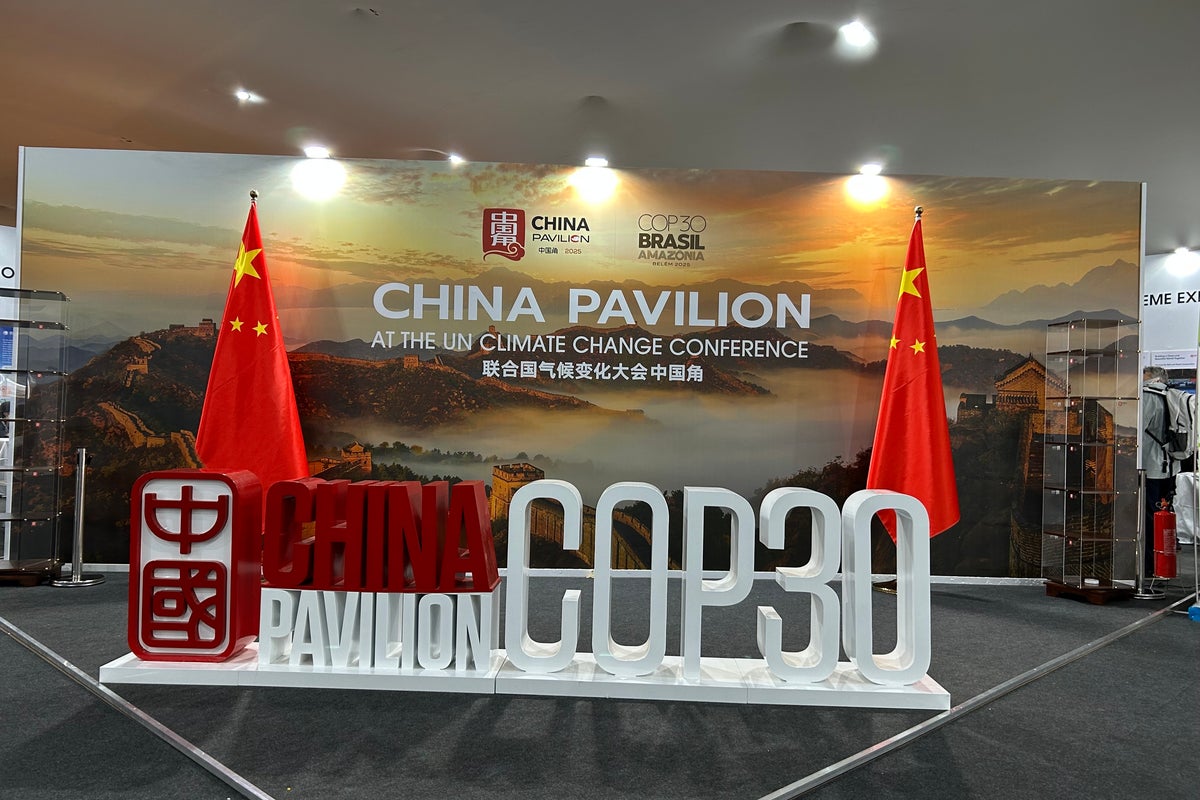The Cop30 climate conference in Brazil has a huge number of country pavilions, where national delegations hold panel events and receptions that are used to represent where their country currently stands in fighting the climate crisis.
The US has no official national pavilion this year – with Donald Trump labelling the climate crisis a “con job” – but China, the world’s top polluter, has a massive plot right in front of the entrance to the Cop30 site. The design reflects confidence in the country’s ambition, with posters profiling giant state energy companies that are rolling out the use of renewable energy at breakneck speed, and others detailing the country’s recently-announced pledge to reduce emissions by 7 per cent to 10 per cent by 2035. There are also long queues at the entrance for a calligraphy artist signing people’s names in a traditional script, and several editions of Chinese leader Xi Jinping’s ‘The Governance of China’ on display.’
When the Independent visited China’s pavilion, an ongoing panel discussion on climate action was – unsurprisingly – lavishing praise on China’s climate agenda. But what the speakers said nonetheless reflected a bullishness on China’s part as an emerging climate champion both domestically and for the many countries around the world currently struggling to pay for adapting the devastating impacts of the climate crisis.

“China, we salute you… you’ve come up with innovations that will lead us to a cleaner and safer world despite the increasing effects of climate change,” says Andrea Mjuma, chief economist to the finance ministry in Malawi. For a country that is one of the most climate-stricken in the world, with debt servicing currently consuming more than half of the country’s tax income, China’s success offers inspiration. Mjuma points out that in the 1970s, China’s per capita was actually lower than Malawi’s, but now it is more than $30,000 (£23,000) while Malawi’s is less than $1,000.
“China has demonstrated that it is possible to transition from high carbon consumption to renewable energy… Now Africa can develop renewables very rapidly based on China’s experiences,” he adds. Earlier this year, China announced a $7 billion (£5,3bn) agreement for a large-scale titanium mining and processing project in Malawi.
Meenakshi Raman, from Malaysian climate non-profit the Third World Network similarly praises China as a strong and reliable partner for developing nations – and also offers scathing words on the counter-pressures that the Trump administration has been putting on countries looking to more away from fossil fuels. “On the one hand, at Cop28 [in Dubai in 2023] we agreed to transition away from fossil fuels, on the other hand through US economic tariffs we are supposed to be importing more coal,” she says. “This is schizophrenia… we cannot let rich countries off the hook as much as we do.”
China now produces 60 per cent of global wind turbines and 80 per cent of global solar panels. This has pushed down the cost of renewables for the rest of the world, and helped drive the clean energy revolution currently being witnessed around the world.
Data released ahead of Cop30 showed that Chinese companies have invested a massive $220 billion in 387 green energy projects across 54 countries since 2022, which is more than the post-Second World War Marshall Plan provided, adjusted for inflation, over four years at a time of similar US dominance in manufacturing. Some 75 per cent of these investments have been in developing countries, and the Chinese government claims that solar and wind exports cut global emissions by 4bn tonnes by 2024.
Attendees at the China Pavillion panel event said that it is not only China’s cheap technology that other countries are drawn to, but also the fact that partnerships with China are marked by a level of mutual respect that comes when two countries considered to be part of the “Global South” work together.
“South-South cooperation has been very successful. China provides long-term commitments, and there is a sense that you have an equal partner,” Anne Lindstedt, who was Swedish ambassador for climate change from 2011 to 2015, tells The Independent. “With the West, as exemplified by Trump, you never know if they are going to be there next year – and there can be a sense that you are spoken down to.”
Erik Berglöf, who is chief economist at the Asian Infrastructure Investment Bank – which is a development bank jointly-funded by both European countries and Beijing – tells The Independent that he expects more collaboration between China and Europe in pushing the climate agenda abroad in the coming years. “China has a lot of technologies now, but Europe also has a lot of policy experience that can be very valuable for many emerging and developing partners, and I think working together they can build a lot of trust and promote the overall agenda,” he says.
China’s leadership has been keen to frame its enduring commitment to the climate cause in marked contrast to the US. When announcing China’s new 2035 climate targets, President Xi described the green transition as “the trend of our time” and urged the international community to stay focused on the right track against backlash from any one country.
But we should not expect the Asian superpower to adopt US-style leadership at the UN on climate change, experts warn. “China isn’t trying to replace the US as a Western-style climate leader: It makes clear that it is a developing country,” explains Belinda Schaepe, a policy analyst at the Centre for Research on Energy and Clean Air (CREA) . “It alone can’t fill the climate leadership vacuum created by the US and it focuses instead on pragmatic contributions — expanding renewables, exporting clean technologies, and positioning the green transition as both a global necessity and an economic opportunity.”
“It is no exaggeration to say that China is driving the global energy transition… but we should not expect China to assert what we might call ‘leadership’ in climate negotiations,” agrees Chris Aylett, from the think tank Chatham House. “China has historically played a constructive role in the multilateral climate process, and that’s likely to continue, but it’s not in China’s interests to take steps which would entail additional obligations.”
No plans to fill the aid gap
Investment in renewables is also, of course, not the only thing that needs to be done to address the climate crisis. Another key priority for developing countries is investment in climate adaptation – which experts agree China’s debt-driven, investment-focused approach is less suited to. “The United States Agency for International Development (USAID) by contrast traditionally focused more on grants and technical assistance for a broader range of development goals, including adaptation and institutional capacity building,” explains Schaepe. USAID was dissolved and absorbed into the US State Department earlier this year.
Since it is ranked as a “developing country” at the UN, China has no official obligation under the terms of the landmark Paris Agreement to provide aid to developing countries for climate action – accordingly, China provided less than half of the climate aid provided by the US between 2015 and 2021.
There have been few signs that China is responding in any significant way to the massive cuts to climate aid that have been seen under Trump, according to Ian Mitchell from the Center for Global Development – despite the fact that demands for climate finance from developing countries are becoming ever more desperate.
“China does not appear to be responding to US cuts. Under President Biden, US climate finance reached around $10bn in 2023 and nearly all of that funding has been halted,” says Mitchell. “China’s efforts, though, are much smaller – and are not increasingly quickly.”
Schaepe adds that the “biggest gift” that China could ultimately give to developing countries is to reduce its carbon emissions, having been responsible for 90 per cent of the emissions growth since the Paris Agreement, which is what is driving runaway climate impacts in developing countries.
New CREA analysis released this week showed that for the first time this century Chinese emissions have been flat or declining for the past 18 months – however many wish for China’s decarbonisation to be taking place more rapidly.
“In real terms China’s 2035 climate target [to reduce emissions by 7-10 per cent] is not that ambitious, and it does not go far enough to keep temperature rise below the 1.5°C Paris threshold,” says Rebecca Nadin, from the think tank ODI Global. “On this point, it is hard to argue China is taking on a leadership role especially given China’s continued coal use.”
This article was produced as part of The Independent’s Rethinking Global Aid project








